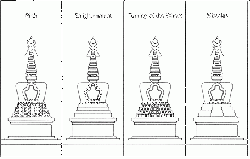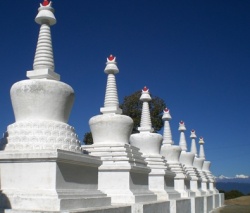How to Build a Stupa
So you want to build a stupa?
Well, are you part of a Tibetan Buddhist meditation group, an academic student undertaking a project for grades, or someone who thinks it would be a great healing aide? Are you thinking desktop size, or in the back yard, or on a carefully chosen spot on your centre's land? You can see, it's hard to give preformatted answers to cover all circumstances!
However, it can be firmly stated that building a stupa is not to be undertaken casually, no matter what the size. According to the instructions I have received, it is important the whole process is supervised by someone who really knows about them, and so far, these individuals tend to be Tibetan Lamas (for Tibetan style chortens). For the styles that developed in Shri Lanka, Thailand, Cambodia, China and elsewhere, obviously the appropriate experienced practitioner should be consulted. The point is, setting about building one merely based on information gained from the Internet, or books, is not good enough. In fact, the Lama who has taught me about stupas was quite serious about it, and said a stupa built without the appropriate consecrations and supervision could be termed a "black" stupa, and as such might actually have a detrimental effect on the local environment, rather than a harmonizing influence.
Now, since I wrote that a few years ago, there have been a few emails from sincere, but worried individuals who wanted a way to ensure their homemade / backyard or mantelpiece sized stupa would not be "black"; given they had no access to a lama. I quizzed Lama Samten about this:
"Black" literally means (in this context) "no proportions, no consecration" (inner and outer), "like a body with no guts".
He said motivation was the most important (so your motivation for building it needs to be as pure / positive as possible)
Ideally, it should have some holy relics, or at the very least, a "life tree" and the "independent" mantra, which starts (in Tibetan) "om yai dharma.....".
The size of the stupa is actually completely irrelevant - in any case the proportions need to be correct. So if it is a tiny little "model" for your mantle, you can still fit a needle sized life tree up inside, and fit a copy of the essential mantra inside (wrapped around the life tree if possible). If these four things (motivation, proportions, life tree and mantra) are all accomplished, this is a form of both outer and inner consecration, so the stupa is no longer "black"
Here is a copy of the "Om yai dharma...." interdependence mantra. The size is such that it should print out one one page if you set your printer to landscape. The copy I have is very small, so it was hard to get the quality up. Please do be careful of the mantra - don't throw away reject copies from your printer. Burning them is only slightly less unacceptable. Better make as few mistakes as possible, so set up your printer slowly and carefully: high quality, landscape etc. Traditionally such pages were stashed, perhaps in a way-side shrine. You can reduce the size, so long as it remains legible, then print as many as you can cram in your little stupa. But even better, track down a lama to add more mantras, and do a more complete consecration.
If you are talking about building a "permanent" stupa, say you are a group with a piece of land you wish to build a stupa on, one of your first steps might be to find a Lama (assuming you don't have a resident one). Such a person might make the following visits during the process:
1 to select the spot, give initial advice (for instance suggesting a list of ingredients you can start collecting for the inside)
2 come back with goodies (some of which you have collected, some of which he has) to bury under foundations and do the first consecration. Any time from now on, the life tree can be prepared, as well as lots of mantras and tsa tsa (which can be done off site). ask for specific advice on tree choosing. (Have to preserve East, for instance)
3 next visit is the wealthy deify section under the main throne
4 maybe visit for protector section within throne, but gelugs don't seem to do this
5 tsa tsas in the four steps (one of the big ones, an all day affair packing them in)
6 the main shrine in the bumpa
7 life tree in, assuming you previously installed a pipe up the centre, down which the life tree is now slipped
8 final consecration
I have been involved in one very successful project where the supervising Lama came far less often than this, so it can vary.
Stupa Construction in New Zealand and Australia.
These are rather crude pages, but the jpegs have been zipped, zapped, stripped and generally treated so meanly they should load quite fast. Some pathetic effort has been made to inject an inappropriately flippant attitude into the accompanying text, possibly in a vain attempt to keep the attention of only faintly interested surfers.
Why bother? Good question.
I don't have an answer to that, but if you are actually interested in building a stupa, I will be very happy to try and answer any questions quite seriously. I love them, built the first one over twenty years ago, when I didn't have a clue. Things could only get better :)
Here is an informative essay by a gentleman in the Philippines, who was involved in the construction of a very well researched stupa. He lists many of the ingredients that went into it. Essay
If you are thinking backyard size, the above advice still stands. If you are thinking to carve or mould a little one for your desk or personal shrine (and would rather make one than buy one), you could still consider trying your best to match the proportions found on the grid and leave a hole up as far as you can inside, then take it to an appropriate person to fill and consecrate....

